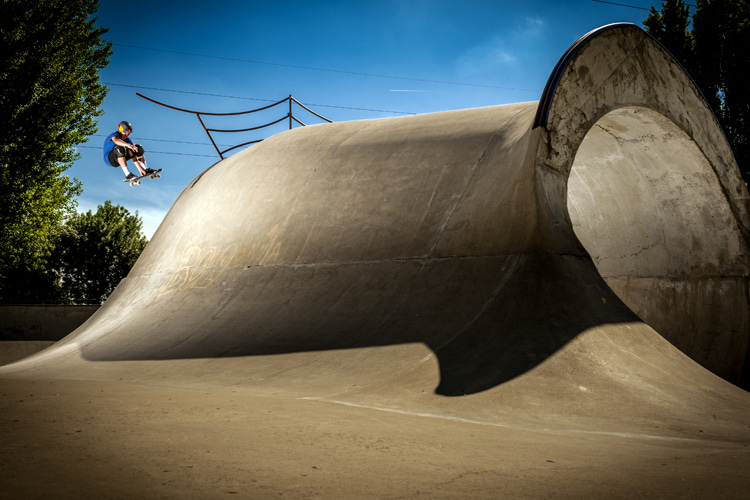Skateparks and city streets are full of rideable features. Discover the complete list of skateboard obstacles and elements.
"Ride everything" - this could very well be skateboarding's motto.
The art of sidewalk surfing is all about exploring the edges and curves of the urban context.
As a result, there's an endless world of possibilities ahead of skaters. All you need is creativity and the will to push your limits.
Some require intense training and practice; others may not be legal to ride.
Here's a comprehensive guide to the riding elements and obstacles that can be explored and enjoyed in your hometown or skating playground.
Bank
A bank is an inclined slope or leaning wall that allows skaters to ride up and down and perform tricks. It is a very common obstacle found in skateparks.
They can also be used to get speed for flatground maneuvers like flip tricks and kickflips.
Banks can have ledges and curbs at the top or hips that connect two structures.
These slanted walls offer plenty of skateable surfaces. Its name was probably inspired by the sloped river banks.
Bowl
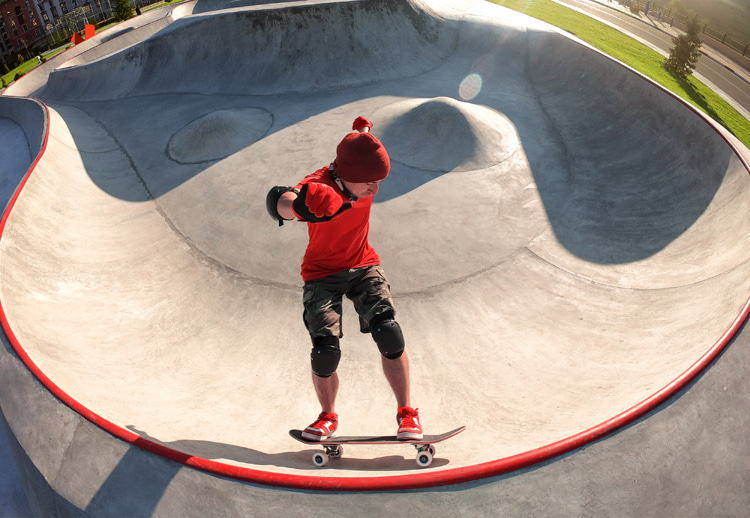
A bowl is a fully or mostly enclosed concrete - or wood - basin sunken into the ground that resembles an empty backyard swimming pool.
They are built in several sizes and shapes (oval, clover, or kidney-shaped) and feature walls that work as transitions for grab or flip tricks.
You can find bowls in almost all high-end, fully certified skateparks.
The best structures feature a coping and a flat bottom, varying depths from five to 20 feet.
The first bowls were California swimming pools that had to be emptied during the 1960s droughts.
They allow skaters to drop in and carve the long concrete walls as if riding an ocean wave.
In a way, they are a sum of curved quarter-pipes.
Cradle
A cradle is a spherical bowl turned sideways. It allows skaters to ride over-verted and inverted and usually connects to a standard bowl.
Curb
A curb is an elongated concrete or stone edging that can be ridden for grind and slide tricks.
It is often less tall than ledges and could have a more or less flat upper surface where skaters perform manual tricks.
Flat Rail
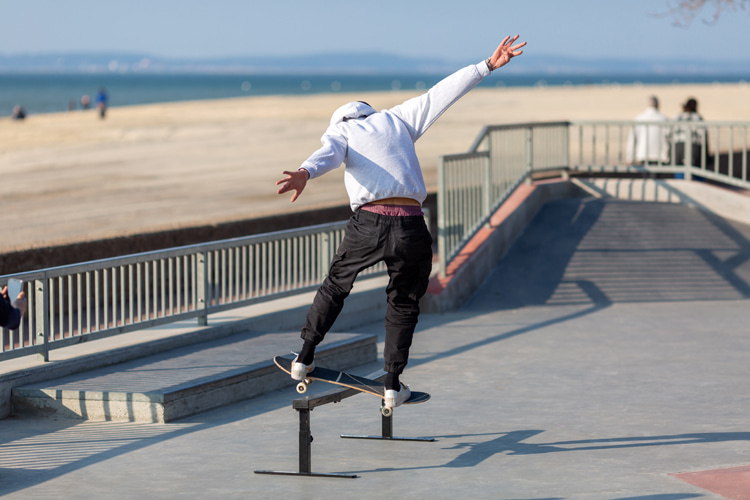
A flat rail is a long metal pole that sits horizontally on the ground and can be found in skateparks with different lengths and heights.
It is widely considered the most accessible type of skate rail and allows riders to perform grinds and slides.
Although the flat rail originally features a rectangular shape, there are also square and cylindrical variations.
It is typically one or two feet tall.
Full Pipe
A full pipe is a 360-degree concrete, wood, or metal barrel or tunnel that allows skaters to ride through, up and down and over-verted.
The ultimate challenge is the full loop, a feat that has only been achieved by a handful of skaters.
Full pipes are usually only available in industrial sites and facilities. As a result, they are one of the rarest and most dangerous skateboard obstacles.
Fun Box
A fun box is a structure that combines different elements, including ramps, rails, hubbas, ledges, banks, coping, or sometimes stairs.
It features a flat table top for launching and obstacles for slide and grind tricks and is often available in skateparks between a bank and a quarter-pipe.
Fun boxes can be set in several combinations of obstacles.
Gap
A gap is a space between two uneven elements, surfaces, or obstacles.
It allows skaters to jump and perform tricks over the empty space between features.
Gaps are naturally available in the street environment but can also be found in skateparks.
The most common gap is between kickers - the longer and more uneven the space between obstacles, the more complex the challenge.
The ollie is the fundamental trick you'll need to master to clear a gap.
Half-Pipe
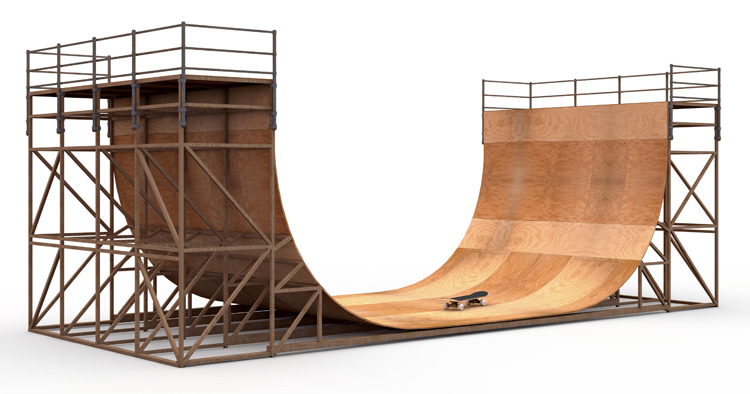
A half-pipe is half of a full pipe or a large mini ramp, with or without vert characteristics, i.e., with a vertical transition curve.
In other words, it's two quarter-pipes opposite each other, featuring a flat bottom transition in the middle.
Half-pipes have two upper decks on each side and the corresponding copings and should be at least 10 feet (three meters) tall.
Riding requires a protective helmet.
Handrail
A handrail is a relatively narrow and long, round, or flat-shaped metal bar that accompanies the slope of a staircase.
It's an advanced skateboarding obstacle that can be found in the urban context and skateparks.
Handrails are extremely hard and dangerous to ride. They can be kinked or straight and make grinding a tough and often bone-breaking challenge.
Hubba
A hubba is a concrete or wooden, tall, narrow, and angled ledge that runs down a staircase, bank, or fun box.
Skaters use it to perform slide and grind tricks.
Kicker
A kicker is a short, inclined, flat surface ramp that allows skaters to jump off high and perform air tricks.
Moveable jump ramps enable riders to create gaps between elements and launch off wherever they want.
Ledge
A ledge is a simple elongated and elevated block with edges that can be found pretty much everywhere.
The more or less high obstacle allows skaters to go slide and grind tricks and even manuals on the upper flat surface.
The edges are sometimes waxed up to maximize flow and smoothness.
London Gap
A London gap is a kicker or bank that allows skateboarders to jump to a higher platform.
On the side, there's a lower flat surface with a gap between both floors.
Manual Pad
A manual pad is a wide and flat elevated platform or surface used for performing manual tricks.
It is very low to the ground and invites skaters to ollie onto it.
Manual pads, also known as wheelie pads, remind boardwalk benches - some feature metal-capped edges.
Mini Ramp
A mini ramp is a small-scale version of a half-pipe.
It consists of two quarter-pipes facing each other with a flat bottom space in between.
Mini ramps are usually no taller than five feet and do now allow skaters to go vert.
Mega Ramp
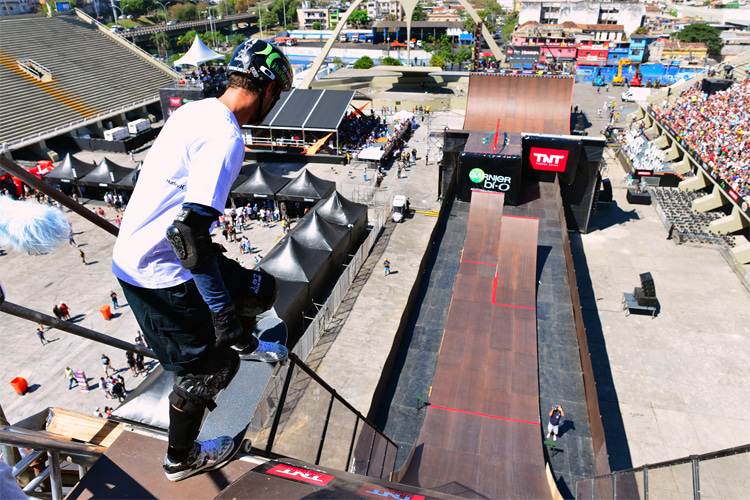
A mega ramp is an XXL vert ramp built for big air skateboarding.
The structure allows skaters to gain speed and launch into huge aerial tricks and maneuvers.
Mega ramps often feature three sections: the roll-in slope, the gap jump, and the vert quarter-pipe.
The length of these large extreme playgrounds varies from 200 to 360 feet (200-108 meters).
Pole Jam
A pole jam is a short and flat metal pole buried in the ground at an angle that enables skaters to grind it and jump off.
The steeper the rail, the hard it is to ride.
Pole jams come in different shapes and sizes and allow skateboarders to unleash their creativity by pulling off no-complies, boneless, grab and flip tricks.
Pyramid
A pyramid is a four-sided ramp with a small flat space on top that resembles a fun box.
The Egyptian-style, pyramid-shaped obstacle can be found and ridden at skateparks.
It is made from four independent banks with flat surfaces and sometimes a transition.
Quarter-Pipe
A quarter-pipe is a convex-shaped mini ramp with a coping and a deck at the top.
It's one of the most popular skateboard elements in skateparks and allows riders to perform and practice all sorts of flat and transition tricks.
Quarter-pipes also enable skaters to gain speed toward other obstacles. They might have - or not - a vert section.
Round Rail
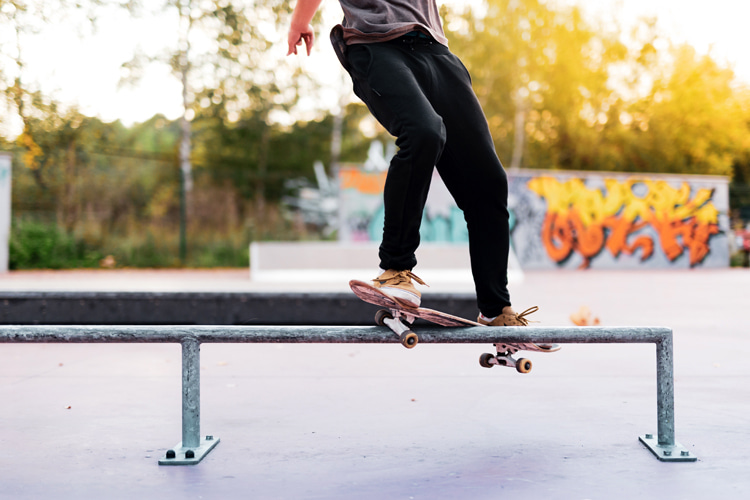
The round rail is a round-shaped metal pole parallel to the ground.
It is the cylindrical version of the flat rail, but it is hard to ride.
Speed Bump
A speed bump is a UFO-shaped concrete hump that can be found in skateparks.
Skaters use it to pump, jump, and gain speed to reach other obstacles.
Speed bumps do not have sharp edges - instead, they're perfectly round and smooth.
Spine
A spine is a triangular-shaped, mountain-style combination of two quarter-pipes placed back to back.
The structure has convex surfaces on both sides, no deck, and allows skaters to perform the so-called spine transfer, an aerial transition from one side to the other.
Stairset
A stairset is a staircase used by skaters to perform flatground tricks and more or less long jumps.
It's the ultimate street obstacle for breaking bones and landing huge airs.
Three and five-stairsets are often available at skateparks, alongside handrails on which skaters do grinds and slides.
Two-step stairsets are great for practicing ollies and kickflips and getting comfortable with larger jumps.
The size of a stairset is based on the number of steps on offer.
Volcano
A volcano is a cylindrical cone with a flat deck on top.
They blend the geometry of pyramids and speed bumps and can often be found in bowls.
Wallride
A wallride is a quarter-pipe featuring a long, steep, and vertical wall.
They can be found in city landmarks and buildings but can also be built and installed in skateparks.
Learning to wallride is an advanced street skating skill.
